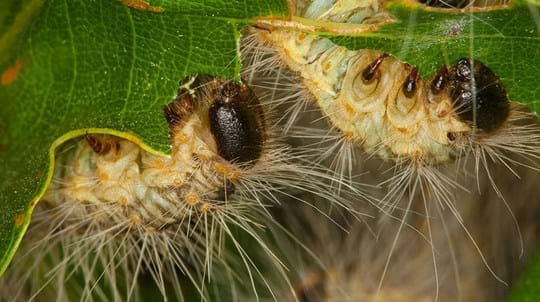
Credit: Marcus Harrison / Alamy Stock Photo
Leaves
Shiny and pinnate (feather-like), with 5–9 paired oval leaflets and one 'terminal' leaflet at the end.
Food of the gods, medicine for the people. Walnut was first introduced by the Romans who, like much of our native wildlife, valued its nuts.
Common name: walnut, common walnut, English walnut
Scientific name: Juglans regia
Family: Juglandaceae
Origin: non-native
Walnut is a deciduous broadleaf tree which can grow to 35m. They typically have a short trunk and broad crown, though can be narrower if grown in a woodland situation. The bark is smooth and olive-brown when young, developing fissures and fading to silver-grey with age. Twigs are stout, green and curving.
Look out for: crushed leaves that smell like polish.
Identified in winter by: the unsegmented inside pith, or spongy centre, of the twig. At their base, buds have horseshoe-shaped leaf scars, or marks, left by fallen leaves.

Credit: Marcus Harrison / Alamy Stock Photo
Shiny and pinnate (feather-like), with 5–9 paired oval leaflets and one 'terminal' leaflet at the end.

Credit: Marcus Harrison / Alamy Stock Photo
Male flowers are drooping yellow-green catkins, 5–10 cm long, and the female flowers appear in clusters of 2–5.

Credit: imageBROKER / Alamy Stock Photo
Pollinated by wind, female flowers develop into a fruit with a green, fleshy husk and a brown, wrinkled walnut.
The botanical name of the English walnut, Juglans regia, means the 'royal nut of Jupiter'.
Black walnut (Juglans nigra). Common walnut has fewer leaflets than black walnut and its leaflets are more oval in shape and have smooth, untoothed edges.

Download our free Tree ID app for Android and iPhone to identify the UK's native and non-native trees. It's an A-Z tree guide in your pocket.
Download the appWalnut is native from south-east Europe to south-west China.
It’s been widely planted throughout the UK and has naturalised in lowland Britain (helped along by hoarding squirrels), in secondary woodland and hedgerows; and on river banks, field-borders and roadsides. It prefers well-drained, fertile and alkaline loam and is found in large gardens and parks.
The leaves are the foodplant for caterpillars of a number of micro moths, and the nuts are eaten by mammals, including mice and squirrels.
The genus for walnut trees is Juglans which originates in Roman mythology. ‘Glans’ is a Latin word that can be translated as 'acorn' but also refers to the head of the male reproductive organ. The association between the nut shape and the male anatomy gave rise to the name.
The word Juglans is believed to derive from Jovis glans, meaning 'Jupiter's acorn' or 'Jupiter's nut'. The Romans associated certain trees with their gods and, in this case, the mighty walnut tree was linked to Jupiter, the king of the gods. The tree's fruit, the walnut, therefore became associated with Jupiter by name. The shape of the walnut might have reminded the Romans of the ‘glans’ or the male anatomy, adding another layer to the name's origin.

Credit: Arco Images Gmbh / Alamy Stock Photo
Walnut was originally grown in the UK for its nuts. Later it was grown for its timber, which is fine with a decorative, wavy grain.
Walnut has a wide variety of medicinal qualities. The leaf is used in the treatment of conditions, including swelling of the skin, acne, ulcers, diarrhoea and excess sweating. The nuts are said to help lower cholesterol, while the shell is used in the treatment of blood poisoning. The leaf is also used in tanning agents and hair dyes.
The English walnut is susceptible to fungal diseases, as well as walnut blight which causes small black spots on the leaflets and can lead to dieback of new shoots and damaged fruit.
Walnut-leaf blotch can cause leaves to fall prematurely but doesn't cause lasting damage to the tree.

Shop
We have single trees and tree packs to meet your needs, from wildlife to woodfuel. Delivery is free.
External link

Trees woods and wildlife
Learn more about the pests and diseases threatening our trees. Find out how to spot them, the symptoms and outlook, and how you can help.